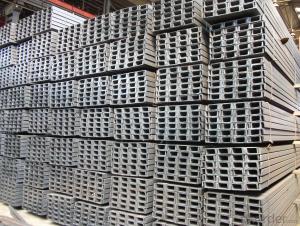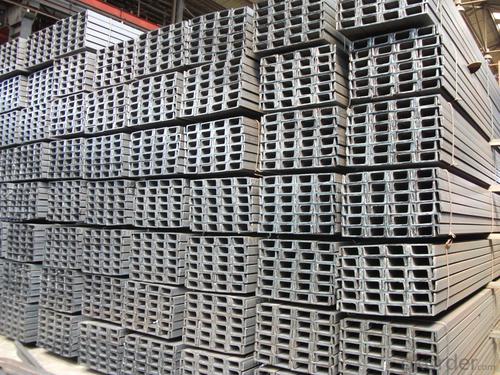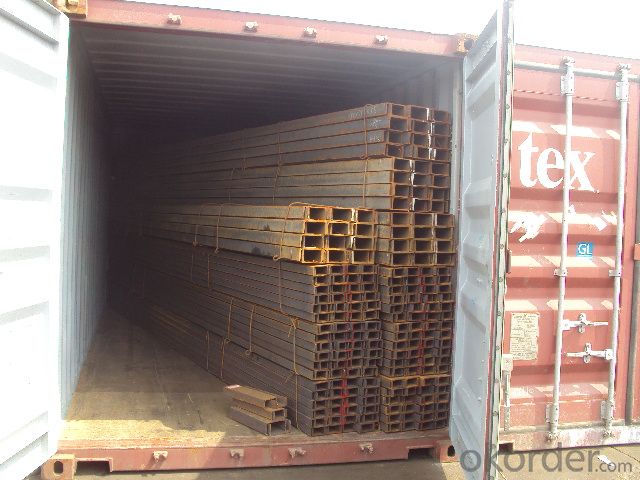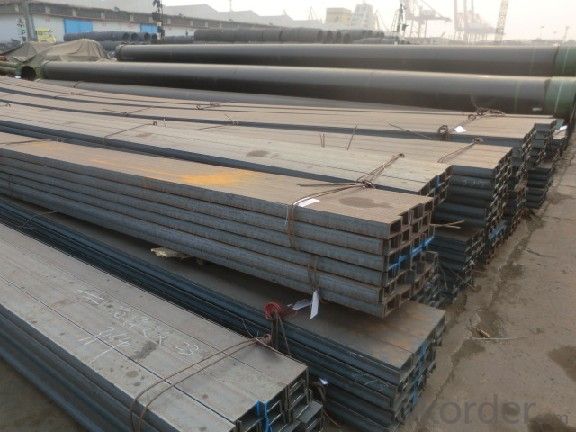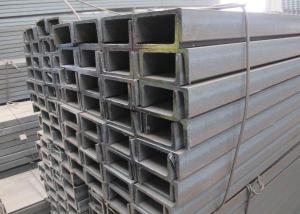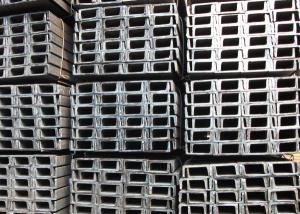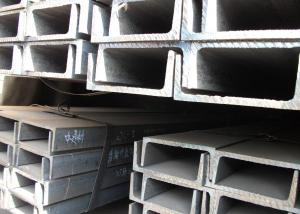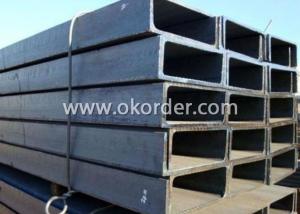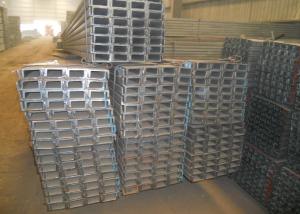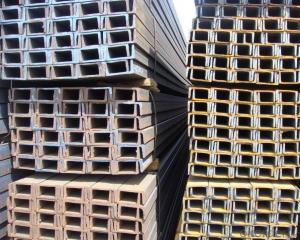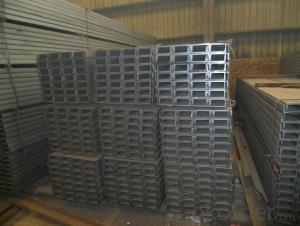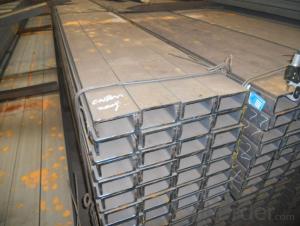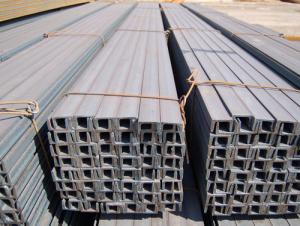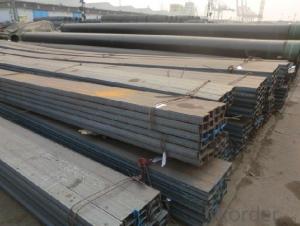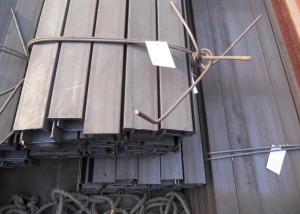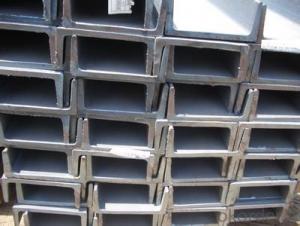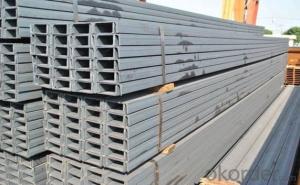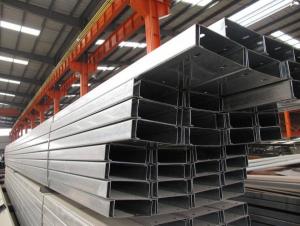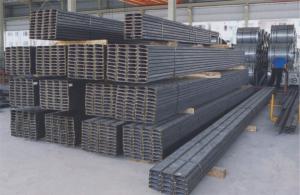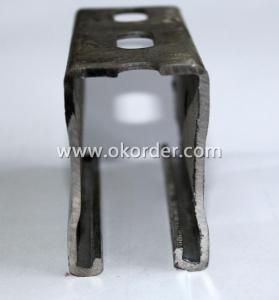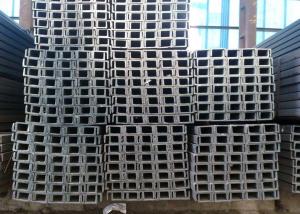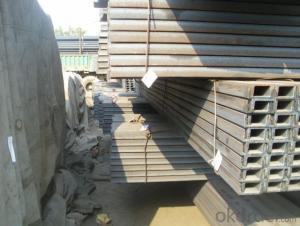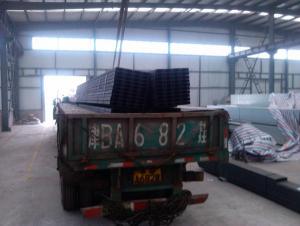U CHANNEL
- Loading Port:
- China Main Port
- Payment Terms:
- TT OR LC
- Min Order Qty:
- -
- Supply Capability:
- -
OKorder Service Pledge
OKorder Financial Service
You Might Also Like
Specifications of MS Channel:
1.We supply high quality MS Channel at reasonable price, including Chinese standard, Japanese standard and so on.
Standard | GB/JIS |
Material Grade | Q235,SS400 |
Technique: | Hot Rolled |
Sizes as per chinese standard: | 50*37*4.5mm - 300*89*11.5mm |
Sizes as per japanese standard: | 50*25*3mm – 200*80*7.5mm |
Length: | 6meter, 9meter, 12meter |
Note: 1.we are also competent to provide our customers other MS Channel based on other sizes according to customer’s requirements.
2. The length of our ms channel could be cut into other meters as per customer’s requirements. For example, the channel in 6meters could be cut into 5.8meters in order to be fit in the 20ft container.
2. The detailed sections of MS Channel as per GB standard.are shown in the table-1:
GB U CHANNEL | Standard | Sectional | Dimension |
| Mass: |
| (mm) | (mm) | (mm) | (mm) |
|
50X37 | 50 | 37 | 4.50 | 7.0 | 5.438 |
63X40 | 63 | 40 | 4.80 | 7.5 | 6.634 |
80x43 | 80 | 43 | 5.00 | 8.0 | 8.045 |
|
|
|
|
|
|
100x48 | 100 | 48 | 5.30 | 8.5 | 10.007 |
120x53 | 120 | 53 | 5.50 | 9.0 | 12.059 |
140x58 | 140 | 58 | 6.00 | 9.5 | 14.535 |
140x60 | 140 | 60 | 8.00 | 9.5 | 16.733 |
|
|
|
|
|
|
160x63 | 160 | 63 | 6.50 | 10.0 | 17.240 |
160x65 | 160 | 65 | 8.50 | 10.0 | 19.752 |
|
|
|
|
|
|
180x68 | 180 | 68 | 7.00 | 10.5 | 20.174 |
180x70 | 180 | 70 | 9.00 | 10.5 | 23.000 |
|
|
|
|
|
|
200x73 | 200 | 73 | 7.00 | 11.0 | 22.637 |
200x75 | 200 | 75 | 9.00 | 11.0 | 25.777 |
|
|
|
|
|
|
220x77 | 220 | 77 | 7.00 | 11.5 | 24.999 |
220x79 | 220 | 79 | 9.00 | 11.5 | 28.453 |
|
|
|
|
|
|
250x78 | 250 | 78 | 7.00 | 12.0 | 27.410 |
250x80 | 250 | 80 | 9.00 | 12.0 | 31.335 |
250x82 | 250 | 82 | 11.00 | 12.0 | 35.260 |
|
| |
|
|
|
280x82 | 280 | 82 | 7.50 | 12.5 | 31.427 |
280x84 | 280 | 84 | 9.50 | 12.5 | 35.823 |
280x86 | 280 | 86 | 11.50 | 12.5 | 40.219 |
|
|
|
|
|
|
300x85 | 300 | 85 | 7.50 | 13.5 | 34.463 |
300x87 | 300 | 87 | 9.50 | 13.5 | 39.173 |
300x89 | 300 | 89 | 11.50 | 13.5 | 43.883 |
Table-1
3. The chemical composition of HR Channel Steel according to Q235B is shown in Table-2.
Alloy No | Grade | Element(%) | ||||
C | Mn | S | P | Si | ||
Q235 | B | 0.12-0.20 | 0.3-0.7 | ≦0.045 | ≦0.045 | ≦0.3 |
Table-2
Note: we are able to present our customers relevant SGS test report for chemical composition of HR Channel Steel.
4. The mechanical property of HR Channel Steel according to Q235B is shown in Table-3-1 and Table-3-2
Alloy No | Grade | Yielding Strength Point(Mpa) | |||
Thickness(mm) | |||||
≦16 | >16-40 | >40-60 | >60-100 | ||
≧ | |||||
Q235 | B | 235 | 225 | 215 | 205 |
Table-3-1
Alloy No | Grade | Tensile Strength(Mpa) | Elongation After Fracture(%) | |||
| | Thickness(mm) | |||||
≦16 | >16-40 | >40-60 | >60-100 | |||
≧ | ||||||
G235 | B | 375-500 | 26 | 25 | 24 | 23 |
Table-3-2
Note: we are able to present our customers relevant SGS test report for mechanical property of MS Channel as customer’s request.
Applications of MS Channel:
The MS Channel can be applied to construction of warehouses, workshops, sport stadiums and car parks etc.The hot rolled channel steel belongs to carbon structural steel which is applied to in the field of construction and machinery.In details, the hot rolled channel steel is usually used for arch-itechtural structure, and they could be welded in order to support or hang a vari-ety of facilities. They are also usually used in combination with I beam. Generally,the hot rolled channel steel we supply must possess perfect welding property, riveting property and mechanical property and so on.
Package & Delivery of MS Channel:
1.The hot rolled channel steel will be packed in bundle with steel wire at each end of every bundle and color marking in order to help the customer to recognize his goods more easily at sight.
2. And the hot rolled channel steel could be loaded into 20ft or 40ft container, or by bulk cargo.If the weight of each bundle reaches more than 3.5 mt, the loading by break bulk cargo should be choosed.When the weight of each bundle reaches less than 3mt, the loading by container should be choosed.
3.As for the transportaion from mill to loading port, the truck will be usually used. And the maximum quantity for each truck is 40mt.
4.All in all, we could do in accordance with customer's request
- Q: I have three houses, the length is 7 meters, the width is 4 meters, I would like to use a 4 meter trough board to do the support, and then put concrete slabs on the channel, the two floor of the roof also do so, can I do that? If it is possible to use a large trough plate, a thick concrete slab, and a thick steel bar for concrete slabs Thank you
- Channel steel can be used as columns, but also a combination of channel steel and concrete as a pillar, the thickness of the board is best to take 120mm, double steel two-way 8@200, three steel enough
- Q: How do steel channels compare to other types of steel profiles?
- When comparing steel channels to other steel profiles, it becomes evident that they possess numerous benefits. Firstly, their high strength and durability are widely recognized. Due to their U-shaped design, steel channels can effectively bear heavy loads without succumbing to bending or warping, making them ideal for structural purposes. Additionally, this strength enables them to withstand extreme weather conditions and external forces, ensuring their longevity. Secondly, steel channels offer exceptional versatility. They can be easily customized and fabricated to meet specific project requirements, making them suitable for a variety of applications, including structural support, framing, and reinforcement. Furthermore, steel channels are available in various sizes and thicknesses, allowing them to be utilized in projects of different scales. Moreover, steel channels exhibit remarkable corrosion resistance. Typically crafted from carbon or stainless steel, which both possess natural anti-corrosion properties, they are well-suited for outdoor and marine environments that are prone to moisture or chemical exposure. Furthermore, steel channels are cost-effective. Being widely available and abundant, steel is relatively affordable compared to other construction materials. Additionally, the durability and longevity of steel channels result in reduced maintenance costs over time, making them a cost-efficient choice for many applications. Lastly, steel channels offer ease of installation. Their uniform shape and standardized dimensions make them simple to work with, thereby reducing installation time and labor costs. This ease of installation also makes steel channels the preferred choice for DIY projects or small-scale constructions. In conclusion, steel channels possess numerous advantages over other steel profiles. Their strength, versatility, corrosion resistance, cost-effectiveness, and ease of installation make them a popular choice for various construction projects.
- Q: Can steel channels be used for equipment platforms?
- Yes, steel channels can be used for equipment platforms. Steel channels are commonly used in construction and industrial applications due to their strength and durability. They provide a sturdy base for supporting heavy equipment on platforms, ensuring stability and safety. Additionally, steel channels can be easily customized and fabricated to meet specific platform requirements, such as size and load capacity.
- Q: After the type of channel is not marked A or B, which shall be calculated?
- For safety reasons, according to the A calculation, the weight of the material can be calculated according to B to avoid the insufficient use time
- Q: 14 of channel steel and 12 of I-beam which force?
- 14 of channel steel should be big.To help you check the manual, 14 of the channel mechanical parameters are greater than 12 of the I-beam, including the moment of inertia, the radius of inertia, cross section coefficients.Therefore, the same length of 14 channel steel can bear a greater force. (of course, in the same force.)However, the weight of channel steel 14 per metre is greater than that of 12 i-beam.
- Q: Do steel channels have any specific acoustic properties?
- Steel channels, like any other material, have specific acoustic properties that can affect sound transmission and reflection. The acoustic properties of steel channels are primarily determined by their density, stiffness, and surface characteristics. One important acoustic property of steel channels is their ability to conduct sound. Due to their high density and stiffness, steel channels can efficiently transmit sound waves. This property is often utilized in applications such as building construction, where steel channels are used to create structural elements that can carry sound from one area to another. Moreover, the surface characteristics of steel channels can influence their acoustic properties. Smooth surfaces tend to reflect sound waves, while rough surfaces can absorb or scatter them. The surface texture of steel channels can be modified to enhance or dampen specific acoustic effects. For example, in some architectural designs, steel channels with textured surfaces are used to reduce echoes and improve sound quality in large spaces. Additionally, the thickness and shape of steel channels can also impact their acoustic properties. Thicker channels generally have better sound insulation properties, meaning they can prevent the transmission of sound waves from one area to another. The shape of the channel can also affect how sound waves travel through it, with different profiles potentially causing alterations in the sound propagation. However, it is important to note that steel channels alone may not possess significant soundproofing capabilities. Additional measures, such as insulation materials, are often combined with steel channels to achieve desired acoustic performance in various applications. In summary, steel channels do have specific acoustic properties that can influence sound transmission, reflection, and insulation. Their density, stiffness, surface characteristics, thickness, and shape all play a role in determining how sound waves behave when interacting with steel channels.
- Q: What are the cost considerations of using steel channels?
- When using steel channels, there are various factors to consider in terms of cost. The first major factor is the price of the steel material itself. This cost can fluctuate depending on market conditions and availability, so it is important to take these variables into account when estimating the overall cost. Another consideration is the fabrication process. To meet specific project requirements, steel channels often need cutting, welding, and shaping. The cost of these processes, including labor, equipment, and materials, should be factored into the project budget. Transportation and shipping costs can also contribute to the total cost of using steel channels. Because steel is heavy and bulky, transporting it from the manufacturing facility to the construction site can be expensive, especially if long distances are involved. Furthermore, the installation process should be considered when evaluating the cost. Depending on the complexity of the project, specialized equipment or expertise may be necessary for proper installation. These additional costs should be taken into account when estimating the overall budget. Lastly, it is important to consider the long-term costs associated with steel channels. Steel is known for its durability and longevity, which can result in lower maintenance and replacement costs over time. However, factors such as corrosion protection and regular inspections should be considered to ensure the longevity of steel channels and prevent unexpected expenses in the future. To summarize, the cost considerations of using steel channels include the price of the steel material, the fabrication process, transportation and shipping, installation, and long-term maintenance. By carefully considering these factors and conducting a thorough cost analysis, informed decisions can be made regarding the use of steel channels in construction projects.
- Q: How do steel channels perform in extreme temperature variations?
- Steel channels are renowned for their exceptional performance in situations where there are significant variations in temperature. The unique characteristics of steel, such as its elevated melting point and exceptional thermal conductivity, enable steel channels to endure extreme temperatures without experiencing substantial deformation or damage. In scenarios where temperatures are elevated, steel channels exhibit remarkable stability and strength. They possess the capacity to withstand the consequences of thermal expansion and contraction, which can lead to warping or cracking in other materials. Moreover, the thermal conductivity of steel facilitates efficient heat transmission, aiding in the dissipation of excess heat and the preservation of the structural integrity of the channels. Similarly, in conditions where temperatures are low, steel channels remain resilient and do not become brittle like certain other materials. This is attributed to the ductility of steel, which allows it to endure the strains caused by temperature fluctuations without fracturing or breaking. Furthermore, steel channels can uphold their shape and structural integrity even in extremely cold environments, rendering them highly suitable for diverse applications. On the whole, steel channels have consistently demonstrated their reliability and exceptional performance in situations characterized by substantial variations in temperature. Whether confronted with high temperatures or exposed to freezing conditions, steel channels are the preferred choice owing to their strength, stability, and ability to resist thermal expansion and contraction.
- Q: What is the concept of nonstandard channel steel compared with the national standard channel steel? Is there any difference in size between the national standard channel steel and the material?
- Channel steel is divided into ordinary channel steel and light channel steel. Standard Specification for hot-rolled plain channel steel is 5-40#. Specifications for hot rolled flexible channel steel supplied by supply and demand agreement are 6.5-40#. Channel steel is mainly used in building structures, vehicle manufacturing and other industrial structures, and channel steel is often used in conjunction with i-beam.
- Q: How do steel channels compare to other structural materials like wood or concrete?
- Steel channels have several advantages over other structural materials like wood or concrete. Firstly, steel channels have superior strength and durability compared to wood. Steel has a high tensile strength, meaning it can withstand heavy loads and pressures without bending or breaking. In contrast, wood is more susceptible to warping, rotting, and insect damage over time. Secondly, steel channels offer greater design flexibility and versatility compared to concrete. Steel can be easily shaped and molded into various sizes and dimensions, allowing for more intricate and complex designs. Concrete, on the other hand, requires formwork and curing time, limiting its aesthetic options. Additionally, steel channels have a higher fire resistance compared to both wood and concrete. Steel does not burn or contribute to the spread of flames, making it a safer choice for structural applications. Wood is highly flammable and can quickly ignite, while concrete may crack or spall under extreme heat. Furthermore, steel channels have a longer lifespan and require less maintenance compared to wood or concrete. Steel is resistant to weathering, corrosion, and pests, reducing the need for regular repairs or replacements. Wood and concrete, on the other hand, may require regular sealing, painting, or patching to prevent deterioration. Lastly, steel channels offer better sustainability and environmental benefits compared to wood or concrete. Steel is a highly recyclable material, and using recycled steel in construction reduces the need for new extraction. Additionally, steel structures can be disassembled and reused, minimizing waste. Wood requires harvesting of trees, which can contribute to deforestation, while concrete production has a significant carbon footprint. In summary, steel channels outperform wood and concrete in terms of strength, durability, design flexibility, fire resistance, lifespan, maintenance, and sustainability. These advantages make steel channels a preferred choice for various structural applications.
Send your message to us
U CHANNEL
- Loading Port:
- China Main Port
- Payment Terms:
- TT OR LC
- Min Order Qty:
- -
- Supply Capability:
- -
OKorder Service Pledge
OKorder Financial Service
Similar products
Hot products
Hot Searches
Related keywords
